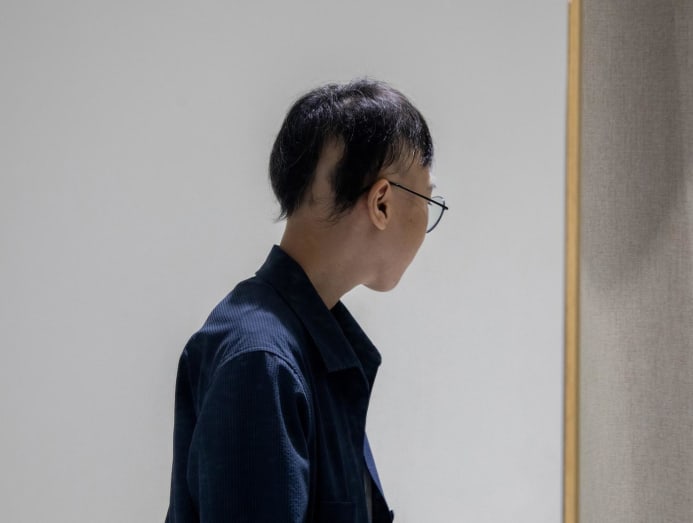The Stories Behind: TikToker hopes others with alopecia feel 'less alone' as she shares lows, laughs of hair loss condition
SINGAPORE — As I prepared to meet 28-year-old Adeline Tay for an interview on her TikTok fame and her journey as an “alopecian”, I found myself mulling over how to be delicate when approaching the subject of her hair loss.
Yet, from the moment I walked into the room, any fear of awkward tension — from either of us — quickly evaporated thanks to her warm and bubbly demeanour.
In hindsight, I shouldn't have been too surprised by this. After all, Ms Tay is also no stranger to being in front of a camera, as a creative strategist and host at digital publisher Our Grandfather Story and content creator on social media platform TikTok.
As one of her more than 40,000 followers on TikTok, where she goes by the username “adelimey” and describes herself as “a botak (Malay for bald) in her trial-and-error era”, I have learnt more about alopecia totalis, the auto-immune condition which causes unpredictable hair loss.
A former officer cadet in the Singapore Armed Forces, Ms Tay was first diagnosed in 2016.
Her first bald spot appeared to be the size of a 20-cent coin-like patch at the back of her head before becoming larger. At one point, she lost around 95 per cent of her hair, including her eyebrows and eyelashes.
One of her most popular TikTok videos showed her colleagues joining her to wear bucket hats as a show of support during an alopecia relapse.
Other popular posts include one that showcased the different haircuts proposed by her barber, as well as those that debunk misperceptions about the condition.
When I met her earlier this month (May 3), she was in her sixth regrowth, referring to a period when some hair grows back.
She was sporting what looks like a pixie cut from the front, though she turned to reveal some patches of hair loss spread across the back of her head.

Despite describing herself as “pretty awkward” offline, as I sat across from Ms Tay for over an hour, my initial wariness of broaching supposedly sensitive subjects dissipated.
What resonated with me, and undoubtedly does too with her online following, is the candour and cheerful courage she brings to navigating everyday life.
Her platform started as a way to raise awareness on living with an auto-immune condition that lacks a permanent cure.
It has now expanded to feature reflections on anything from mental health to documenting the simple joys of buying an inflatable frog keychain.
Almost as if she was comforting me rather than being interviewed by me, much as she does online, she said: “I want to reach people who are trying their best everyday to figure out (how to live) life.
"I hope that if I promote it (alopecia) and normalise it, I get to reach out to people who are like me, and let them know it is fine. We all grow at our own pace.”
A LIGHTER APPROACH TO ALOPECIA AWARENESS
The start of her TikTok stardom was a happy accident, as her first viral video in October 2021 was the incessant morning call of an Asian koel bird in her neighbourhood.
“I have never imagined myself being a content creator. I do make funny videos, but that is just for my friends, and I posted that video not knowing it would appear on other people’s 'for you' pages as well,” said Ms Tay.
In her second video of the noisy bird, she accidentally included herself in the video, which drew comments from viewers who asked about her then thinning and mostly white hair.
True to her aims to keep things light, she initially joked in reply that her hair loss was because she ate too much instant noodles or because of academic stress.
She then made a segue to spread awareness about her auto-immune condition.
Ms Tay now has a series of over 30 videos called “All about Alopecia”, where she has shared on how she copes with hair loss and has fielded questions such as: Are you a boy or a girl?
Becoming a content creator is another one of life’s twists and turns for Ms Tay, and cracking jokes about her condition is something she could not have imagined years ago.
“When I was first diagnosed, I was really depressed and hid away for a good while. I didn't even look in the mirror back then,” she said.
She added that during that initial period she and her family had become more dejected as they explored various treatments to no avail.
“I didn’t have eyebrows then, but I had a white board marker at home, so I tried drawing my eyebrows with a whiteboard marker. I found it pretty funny, and saw my parents laughing, and I thought: 'Why not? Just learn to find joy in it'.”
'UNASHAMED' OF BEING HERSELF
Yet even as Ms Tay’s humour shone through, it did not take long before our conversation treaded into personal matters closer to her heart.
Though she set up her platform to spread awareness about alopecia, Ms Tay said it has become like a journal for her, as her physical and mental health journey has been anything but linear.
When I asked how she feels about her current stage of hair regrowth, she admitted that she was initially hesitant to talk about it out of fear of the next relapse.
“Even to this day, I’m pretty afraid. You get paranoid when you wake up and you see hairs on your pillow or when you shower, there’s more hair than usual,” said Ms Tay.
“When I go through a relapse, it’s not just myself, it’s the people around me who go through it emotionally too. I’m afraid of getting people’s hopes up and disappointing them again.”
More than a cosmetic problem, she added that the emotional experience of having alopecia should not be discounted as people with the condition can feel helpless as they do not have agency over an important, highly visible part of their appearance.
On her TikTok platform, she often shares her emotions in documenting her “growing pains” in the areas of work, relationships and health.
“Dealing with mental health and the relapses of alopecia, there are good and bad days. Some days you will be so happy and another I might be crying in another TikTok video."
She added that there is no formulaic approach to what she does, just a wish to "document life" as an adult doing her best.
Ms Tay tells me that she makes edits before posting — such as trimming a recent emotional two-minute video on friendship breakups down from 40 minutes.
Still, she said that her platform is one where she is “unashamed” to share the downsides of life, as she hopes it helps others feel “less alone”.
It is this vulnerability that has connected her with others with similar struggles, many of whom have thanked her over direct messages for sharing her mental health journey and made their own confessions such as having difficulty getting up in the morning.
She recalled realising the “very real” impact her videos had when a cancer patient tagged her in a video, stating that she had been inspired to shave her hair off because she had seen Ms Tay openly discussing her hair loss.
On another occasion, during a period when Ms Tay had patchy hair, she encountered a mean comment from a group of secondary school students. One of the boys in the group had blurted out while she was within earshot: “What’s up with her hair?”
She was stunned, but was then encouraged by the reaction of another boy, who turned out to be familiar with her content and chided his friend by stating that she was a TikTok creator and that her hair loss was because she was sick.
“It showed me that people help. Sharing my story does help, because what if out there in a secondary school, there’s someone with alopecia?” said Ms Tay.
As for any advice she might have to those who want to try being similarly open or vulnerable online, Ms Tay said: “With every (piece of) content, I think quite a bit before I post. You must make sure that you are comfortable, it shouldn’t be something that’s pressuring.”
“A digital footprint is a very real thing, I’m pretty sure there’s a video of me putting tattoos on my head that will be there forever, when I’m 60 I’ll probably have to look at it,” she added with a laugh.
“I’m comfortable, that’s why I share it. So don’t feel like you have to do it, because there’s a lot of different ways you can advocate for things, without putting your face in front of the camera.”








